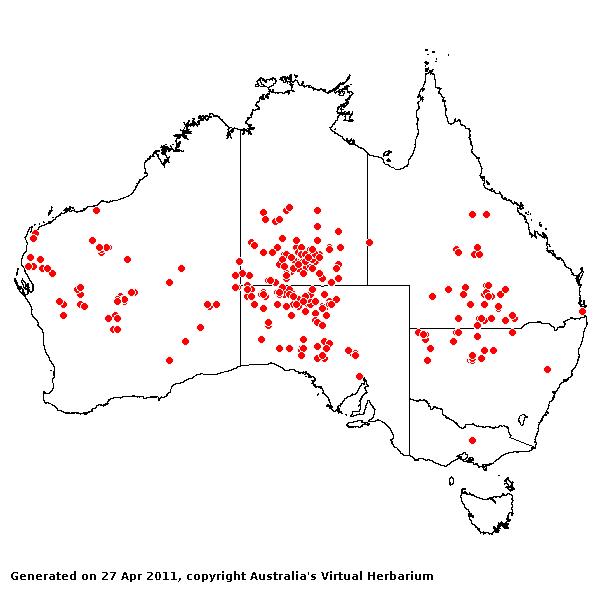Eriachne helmsii (Domin) Hartley. J.
Linn. Soc., Bot. 52: 346 (1942).
Classification. (GPWG 2001) : Subfamily
Micrairoideae. Eriachneae.
Basionym and/or
Replacement Name: Eriachne
mucronata var. helmsii Domin, Bibl. Bot. 20:361 (1915).
Type of Basionym or
Protologue Information: Australia, Ferdinand R.: Helms (K holo).
Key references
(books and floras): [1952] C.A.Gardner, Flora of Western Australia 1
Gramineae (51), [1981] M.Lazarides in J.Jessop (ed)., Flora of
Central Australia (441), [2002] D.Sharp & B.K.Simon, AusGrass,
Grasses of Australia, [2006] J.Jessop, G.R.M.Dashorst, F.M.James, Grasses
of South Australia (420), [2008] S.W.L.Jacobs, R.D.B.Walley &
D.J.B.Wheeler, Grasses of New South Wales (261).
Illustrations:
[1952] C.A.Gardner, Flora of Western Australia 1 Gramineae (47,
Pl. 12), [2006] J.Jessop, G.R.M.Dashorst, F.M.James, Grasses of South
Australia (420, fig. 351), [2008]
S.W.L.Jacobs, R.D.B.Whalley & D.J.B.Wheeler, Grasses of New South Wales,
4th edn (261).
Habit.
Perennial. Culms geniculately ascending or decumbent, 40–90 cm tall, wiry, 6–10
-noded. Mid-culm nodes glabrous or pubescent or bearded. Lateral branches
branched. Ligule a fringe of hairs. Leaf-blades flat or involute, 2.5–16 cm
long, 2–3 mm wide. Leaf-blade surface scaberulous, indumented.
Inflorescence.
Inflorescence compound, a panicle. Panicle linear or oblong, loose, 3–11(–18)
cm long, 0.8–2 cm wide.
Spikelets. Spikelets
pedicelled. Fertile spikelets 2-flowered, both fertile, comprising 2 fertile
floret(s), without rachilla extension, ovate, laterally compressed, 5–7 mm
long.
Glumes.
Glumes similar, thinner than fertile lemma. Lower glume ovate, membranous,
without keels, 9–11 -nerved. Lower glume surface glabrous. Lower glume apex
muticous or mucronate. Upper glume ovate, 4–8.5 mm long, membranous, without
keels, 9–11 -nerved. Upper glume surface smooth, glabrous. Upper glume apex
muticous or mucronate.
Florets. Fertile
lemma 5–9.5 mm long, without keel, 5–7 -nerved. Lemma surface indumented. Lemma
apex muticous. Palea apex entire or erose or dentate, muticous. Grain 2.7–3.2
mm long.
Continental
Distribution: Australasia.
Australian
Distribution: Western Australia, Northern Territory, South Australia,
Queensland, New South Wales.
Western Australia:
Hall. Carnegie, Giles, Fortescue, Carnarvon, Austin. Northern Territory:
Central Australia North, Central Australia South. South Australia:
North-western, Lake Eyre, Nullabor, Gairdner-Torrens Basin, Eyre Peninsula. Queensland:
Gregory South, Maranoa, Mitchell, North Kennedy, Warrego. New South Wales:
North-Western Plains, North Far Western Plains.
Notes.
A prominent character of E. helmsii is its bulbous, woolly base, sometimes
the characteristic crinkly hairs extending along the lower culm internodes and
leaf sheaths, and occasionally (e.g. in Aplin & Trudgen 5720) on all
internodes. Other distinguishing characters include the loose straggly habit,
wiry coarse culms, linear rather loose panicles, florets usually longer than
glumes with appressed lemma and palea, obtuse entirely bearded callus,
acuminate awnless lemmas with indumentum on surface and margins, and the
strongly compressed caryopsis. The spikelets of E. helmsii resemble
those of E. mucronata, but this species has abruptly contracted (not
gradually narrowed) consistently mucronate lemmas with glabrous (not ciliate)
margins, and a slightly thickened, pubescent (not bulbous, woolly) rootbase.
The specimens, Cleland C/A 10/36, Smith & Everist 990, Sutherland
6 and Symon 2424, are intermediate in these features and may
represent putative hybrids.
Endemic.
All mainland States except Victoria, predominantly in arid and semi-arid areas
and extending N to about the Tropic of Capricorn. A common species of deep
sands and sandy loams on dunes, sandplains and sandhills; recorded also from
quartzite outcrops, sandy levees, upper margins of saline lakes and
"samphire" flats, interdunal swales, hard red and red-brown fine-textured
soils, colluvial limestone hillslopes, and lateritic gravelly sandridges.
Throughout its distribution range, the species flowers and fruits in all
seasons, but chiefly Dec.-May (summer and autumn), extending to Sept.-Oct.
(spring).








